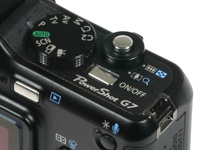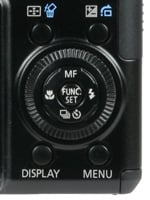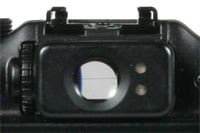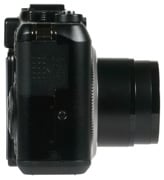Canon PowerShot G7
-
-
Written by Gordon Laing
Canon PowerShot G7 design and controls
The Canon PowerShot G7 is a smart-looking compact borrowing design cues from classic rangefinders and appealing to photographic enthusiasts. It’s bigger and heavier than most compacts, and best-suited to carrying around in a bag or larger coat pocket.
That said, measuring 106x72x43mm and weighing 363g with battery, it’s considerably slimmer and lighter than its predecessor, the G6, and also roughly comparable to the PowerShot A640.
Like earlier PowerShot G models, the build quality is excellent. To put its size into perspective we’ve pictured it below alongside the Fujifilm F30 and Canon EOS 400D / Rebel XTi.
Unlike the A640 and G6 though, the new PowerShot G7 has a virtually flat front, bereft of a traditional grip to wrap your fingers round. There’s a thin raised vertical strip on the front which provides surprisingly effective purchase for your middle and ring fingers, but overall it doesn’t feel as secure in your hand as its predecessor, nor the A640. This could be an issue if you’re intending to regularly use the G7 with its optional lens and flash accessories which significantly increase the overall size and weight.
 |
|
The G7’s control layout is also a significant change from the G6, although mostly in a good way – and with a couple of surprises thrown in too. The main Command dial has been sensibly relocated from the rear to the upper surface, although sadly the trademark G-Series LCD status screen has been lost. Shooting modes consist of the usual Auto, Program, Manual, Shutter and Aperture Priority, along with Stitch Assist, Movie, two custom modes and SCN which allows you to choose from a selection of 16 scene presets. Full details of the creative and exposure options can be found in our Features section.
To the right of the Command dial is a newly designed shutter release button surrounded by a circular zoom rocker. The shutter release button itself feels quite unusual being taller and narrower than the traditional flat and wide shutter releases. This height and shape along with the pressure required to lock focus takes a little getting used to, and at first you’ll accidentally take pictures when you only intended a half-press. Before long you get the hang of it though.
Like previous G series cameras, there’s a wealth of flash options including a built-in unit (with rear-curtain and compensation settings) along with a full hotshoe which supports auto exposures with the Speedlite 220EX, 430EX or 580EX models; other flash guns operate manually. There’s also an optional HF-DC1 High Power flash unit which attaches to the side of the camera using a tripod bracket and supplements the built-in flash. Support for external flashguns, especially proper Speedlite units, was always one of the aspects which took the G-Series beyond normal compacts and we’re pleased to find the facility is still present on the G7.
 |
To the left of the hotshoe is the first of the G7’s control surprises: a dial dedicated to ISO settings. The dial allows you to quickly select sensitivities from 80 to 1600 ISO along with Auto and Hi options, the latter still operating automatically, but exploiting the full range of sensitivities. Note: the highest 3200 ISO sensitivity (which operates at a reduced 2 Megapixel resolution) is selected through a dedicated scene preset.
 |
Turning to the rear of the camera, you’ll find the second of the G7’s surprise controls: a flat control wheel which works like a mini version of the wheels found on the back of Canon’s higher-end EOS DSLRs. Spinning it clockwise or anti-clockwise with your thumb allows you to quickly adjust aperture and shutter values, exposure compensation, manual focus distances, and of course scroll through menu options.
We’ve always been fond of Canon’s rear-mounted DSLR wheels at Camera Labs and while the G7’s wheel isn’t quite as tactile, it’s still a welcome addition for a compact. It should be noted though that unlike the DSLRs (and many compacts), the G7 doesn’t additionally employ a conventional thumb or finger dial near its shutter release. Also unlike the Canon DSLRs, the G7’s wheel additionally features the more traditional four-way joypad-style buttons in the middle for further navigation and selection.
Finally, if you’d like to take the PowerShot G7 underwater, the optional WP-DC11 case is rated at depths up to 40m while the WW-DC1 accessory provides additional weights to prevent the camera and case from floating.
Viewfinder
 |
The PowerShot G series always featured an optical viewfinder in addition to the main colour monitor, and Canon’s wisely kept this alternative for composition on the G7. Optical viewfinders may seem primitive compared to using a nice, big colour screen, and it’s slightly quaint to see the G7’s lens appearing in the corner when it’s zoomed-out, but there are benefits.
The main benefit is having an alternative means of composition when the colour screen becomes hard to view, such as under direct sunlight. Since you’re not using any power to illuminate a colour screen when composing with the optical viewfinder, you’ll also extend your battery life. Of course it’s unlikely you’d use the viewfinder exclusively for composition and unlike the screen it won’t show 100% coverage, exposure information nor focus indication beyond a light, but it’s still good to have as an option.
Battery
and connectivity
Like its predecessor, the PowerShot G7 is powered by a single rechargeable Lithium Ion battery pack, inherited from a Canon DSLR. But while the earlier G6 employed the relatively hefty BP-511(A), the G7 uses the much smaller and lighter NB-2LH found in the EOS 350D (XT) and 400D (XTi).
With roughly half the charge capacity, it’s not surprising to find the G7’s battery life is shorter than its predecessor, but internal power savings mean you’re only looking at around a 25% decrease: Canon quotes 220 shots for the G7 compared to 300 for the G7 under CIPA conditions. The smaller battery also contributes to the G7 being lighter and much narrower than its predecessor, although the G6 at least had more of a grip as a consequence. In our tests we managed to take around 200 shots with a fully-charged battery and this included videos, bursts and several long exposures under cold conditions. Image Stabilisation was set to continuous throughout.
 |
Further space savings on the G7 have been possible thanks to the swap from Compact Flash to SD memory. The G7 supports SDHC and like its predecessor is supplied with a 32MB card, although again that really is just a taster – budget for a much bigger card straightaway.
The G7’s SD card slot is located alongside the battery compartment behind a door on the underside, which annoyingly becomes inaccessible when the camera’s mounted on a tripod. The G7’s two ports for AV out and USB are hidden behind a door on the right side, but there’s no DC-input. Instead for mains powered operation you’ll need to buy the optional ACK-DC20 kit which employs a dummy battery adapter. The G7 does of course come with a mains recharger for its battery though.




